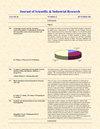Predicting Student Performance with Adaptive Aquila Optimization-based Deep Convolution Neural Network
IF 0.8
4区 工程技术
Q3 ENGINEERING, MULTIDISCIPLINARY
引用次数: 0
Abstract
Predicting student performance is the major problem for enhancing the educational procedures. A level of student’s performance may be influenced by several factors like job of parents, sexual category and average scores obtained in prior years. Student’s performance prediction is a challenging chore, which can help educational staffs and students of educational institutions to follow the progress of students in their academic activities. Student performance enhancement and progress in educational quality are the most vital part of educational organizations. Presently, it is essential for an educational organization to predict the performance of students. Existing methods utilized only previous student performances for prediction without including other significant behaviors of students. For addressing such problems, a proficient model is proposed for prediction of student performance utilizing proposed Adaptive Aquila Optimization-allied Deep Convolution Neural Network (DCNN). In this process, data transformation is initiated using the Yeo-Johnson transformation method. Subsequently, feature selection is performed using Fisher Score to identify the most relevant features. Following feature selection, data augmentation techniques are applied to enhance the dataset. Finally, student performance is predicted through the utilization of a DCNN, with a focus on fine-tuning the network parameters for optimal performance. This fine-tuning is achieved through the use of the Adaptive Aquila Optimizer (AAO), ensuring the network is poised to deliver the best possible results in predicting student outcomes. Proposed AAO-based DCNN has achieved minimal error values of Mean Square Error, Root Mean Square Error, Mean Absolute Error, Mean Absolute Percentage Error, Mean Absolute Relative Error, Mean Squared Relative Error, and Root Mean Squared Relative Error, respectively.基于自适应Aquila优化的深度卷积神经网络预测学生成绩
预测学生的表现是提高教育程序的主要问题。学生的表现水平可能受到父母职业、性别类别和前几年平均成绩等因素的影响。学生成绩预测是一项具有挑战性的工作,它可以帮助教育工作者和教育机构的学生跟踪学生在学业活动中的进展情况。学生成绩的提高和教育质量的提高是教育组织最重要的组成部分。目前,对一个教育机构来说,预测学生的表现是必不可少的。现有的方法仅利用学生以前的表现进行预测,而没有考虑学生的其他重要行为。为了解决这些问题,我们提出了一个熟练的模型来预测学生的表现,利用我们提出的自适应Aquila优化相关的深度卷积神经网络(DCNN)。在此过程中,使用杨-约翰逊变换方法启动数据转换。随后,使用Fisher评分进行特征选择以识别最相关的特征。在特征选择之后,应用数据增强技术来增强数据集。最后,通过使用DCNN来预测学生的成绩,重点是微调网络参数以获得最佳性能。这种微调是通过使用自适应Aquila优化器(AAO)来实现的,确保网络在预测学生成绩方面能够提供最好的结果。本文提出的基于aao的DCNN分别实现了均方误差、均方根误差、绝对误差、绝对百分比误差、绝对相对误差、均方相对误差和均方根相对误差的最小误差值。
本文章由计算机程序翻译,如有差异,请以英文原文为准。
求助全文
约1分钟内获得全文
求助全文
来源期刊

Journal of Scientific & Industrial Research
工程技术-工程:综合
CiteScore
1.70
自引率
16.70%
发文量
99
审稿时长
4-8 weeks
期刊介绍:
This oldest journal of NISCAIR (started in 1942) carries comprehensive reviews in different fields of science & technology (S&T), including industry, original articles, short communications and case studies, on various facets of industrial development, industrial research, technology management, technology forecasting, instrumentation and analytical techniques, specially of direct relevance to industrial entrepreneurs, debates on key industrial issues, editorials/technical commentaries, reports on S&T conferences, extensive book reviews and various industry related announcements.It covers all facets of industrial development.
 求助内容:
求助内容: 应助结果提醒方式:
应助结果提醒方式:


